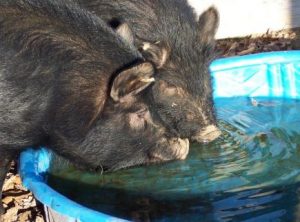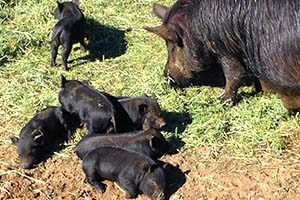Guinea Hog owners use a variety of ways to provide water for their pigs, as well as provide a variety of diets, and AGHA is collecting many different descriptions of feeding systems as well as photos of watering systems.
Water is an Important Necessity
WATER: Water must be made available at all times. Here are some photos of water containers, ranging from kiddie wading pools to water tanks purchased from the feed store.



FEED: While most breeders keep their Guinea Hogs on pasture, and Guinea Hogs are renowned for being grazers and enjoying grass, most breeders also supplement their diet with other feeds, either purchased-in specifically, or left-overs from the kitchen, or some combination of both.
Some breeders feed once a day after the pigs have browsed all day, and other breeders feed twice a day. Most or all breeders provide grass hay during winter, or when there is no pasture.
Feeding Styles and Systems
There are a variety of feeding systems or styles, none “better” than the other, but merely a matter of personal preference on the part of the breeder. Various feeding systems, in no particular order:
- One farmer provides pasture and/or hay daily, and also feeds a variety of foods that vary from day to day, including garden produce, kitchen scraps, chicken culls, eggs-too-dirty-to-use-in-the-kitchen. Especially in winter, a bit of COB is given each evening after the pigs have browsed the pasture (or hay) during the day. COB is a purchased mixture of corn, oats and barley.
- Another farmer provides, in addition to pasture or local grass hay, a supplement twice a day of a small amount of whole wheat and a cup of hog pellets.
- Yet another farmer feeds only a minimum amount of grain due to the fact that “these hogs eat like hogs, surviving on garden trash, table scraps and other stuff a farm produces. We avoid feeding corn to them as much as possible. Corn seems to produce obesity which can hamper reproduction.” In addition to moving their portable pens regularly to fresh grass, they “feed them a ration of milo, oats, corn gluten, soy hull pellets, wheat, bran and beet pulp. I purchase this custom mixed feed from the local mill.”

Hogs enjoying their hay.
While there are as many different feeding regimes as there are farmers, they have one thing in common; these pigs live primarily on pasture and/or hay, and get supplemented with what the farmer has on hand or prefers to buy in.
